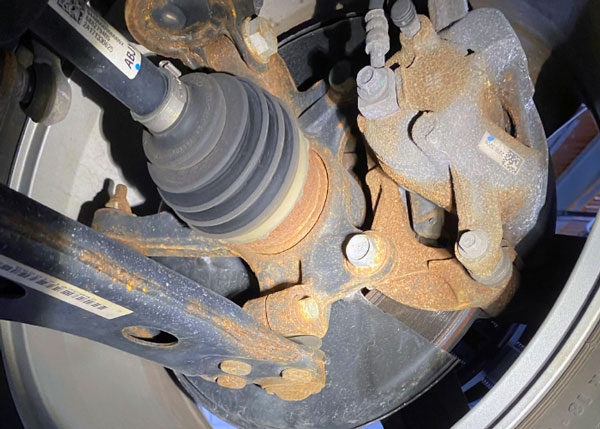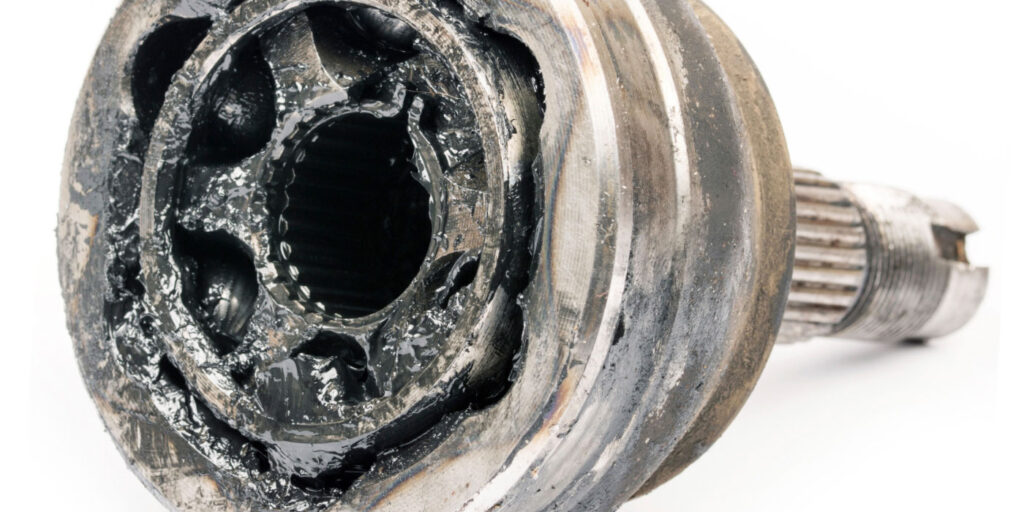Alfred Hans Rzeppa was an engineer with Ford in the 1930s. He came up with the idea to improve the universal joint. Instead of four bearings mounted in two yokes, Rzeppa used six balls mounted in paths. His invention made WWII Jeeps’ front axles more durable. And, 25 years later, his constant velocity (CV) joint made front-wheel-drive vehicles possible.
The CV joint transmits power at a variable angle and at constant rotational speeds. In a front-wheel-drive car, the joint allows the driveshaft and wheel to rotate at a constant rate while the steering and suspension move.
If a CV joint fails, it rarely fails on its own. Outside factors like transmission mounts and suspension angles can damage a joint worse than cutting a boot with a knife.
1. Axle Alignment
If the subframe or mounts are misaligned, the geometry of the inner and outer joints will be altered. For outer joints, the CV joint may exceed the maximum angle of operation. For inner plunge joints, the axle could bottom out. If the replacement axle is close but not precisely made to the correct specifications, the axles’ misalignment can be even more compounded. Also, some manufacturers like Honda have a centering procedure that involves loosening the motor mounts and installing the axles.
Pay attention to modified vehicles. If a truck is lifted, it changes the operational angles of the joint. Most CV joints can allow for 45º of movement. Excessive angles for prolonged periods of time can cause wear to the race and balls of a CV joint. The same is true for lowered vehicles.
There are aftermarket options for lifted trucks that are longer and designed to take the abuse.
2. Wrong Axle, Bad Engineering
Sometimes, issues with a wrong axle can occur if it is not ordered correctly. On some vehicles, the difference between the manual and automatic transmission axle length might be a few millimeters, but it might cause a plunge joint to be too shallow or too deep. If the axle is too long, it can cause the CV or plunge joint to bottom out and damage the surfaces of the balls, bearings and races. If it’s too short, the axle could pull out of the plunge joint under certain conditions.3. Vehicle Alignment
If a CV joint has failed, look at the condition of the suspension. Bent components can cause the range of motion of the joint to change. On the alignment rack, make sure you check the included angle to see if a steering arm or strut rod is bent.

4. Too Much Grease
You never want to add too much grease to a CV joint. The CV joint can get hot due to internal friction and heat transferred from the brakes and engine. The heat can cause the grease and air inside the joint to expand. The pressure can cause the boot to be forced off the body of the joint.
5. Seals
When installing a new axle or driveshaft, one mistake made by technicians is not addressing the seals in the transmission, differential or transfer case. Most seals ride on a shaft and typically have a lip and a spring that hold the lip to the axle. When a seal is installed, take your time installing the axle. Splines can damage the seal and cause leaks.
The area on the shaft where the seal and bearings make contact is the most important. It must be free of any rust and imperfections. Use only a fine-grade emery paper to clean the axle shaft between the flange and the worn area.
If the surface is grooved or damaged, the axle can be repaired with a sleeve on some applications. If not, the axle should be replaced. Make sure the seal is installed in the correct position.
6. Replacing Just the Boot
You might think you caught a CV joint before all of the grease was ejected, but the damage might have already occurred. CV joint housings are typically forged from iron billets. After the joint is machined, induction heat-treating is used to harden wear surfaces. Wear in a CV joint usually occurs on the cage, gear and cup. This wear is typically caused by a loss of lubrication due to a boot failure or debris in the joint. Once heat-treated surfaces are damaged, they usually cannot be restored.
7. Clicking or Popping
If a customer reports clicking or popping after an axle or wheel bearing has been replaced, it could be coming from the shoulder area of the axle where it meets the inner race of the bearing. Nissan, BMW and Mercedes-Benz have issued TSBs on how to cure noise that occurs under cornering, braking and acceleration.
The solution for all of the OEMs is to apply a light coating of moly lubricant to the shoulder of the CV axle. The other cause for the clicking and popping noise cited in the TSBs was a failure to follow the correct procedures when tightening the axle nut.














